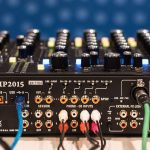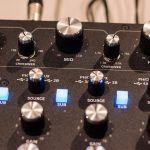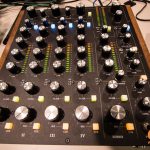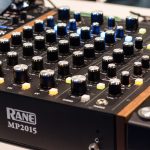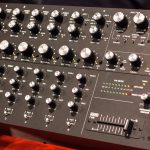Are trade shows fun again?
Being who we are and doing what we do as part of DJWORX allows us to mess with every new piece of kit that hits the market (and some that don’t). We analyze, we dissect, we take pictures and write words – and sometimes, we get a little excited. Getting our minds blown, however, is something that doesn’t happen very often – especially in today’s overcrowded market, where the overabundance of boringly similar products leads to design decisions made for the sake of marketability over actual useability. It’s blatantly obvious that the wrong people are in control, trying to make us think we need certain features (has anyone actually ever used Flips? just asking), although we really don’t.
So, while the larger part of the industry has been busy trying to refabricate a friction-reducing rotary transportation enhancement device using the algebraic equation x² + y² = r² (reinvent the jogwheel) and sell it, Rane has calmly stepped onto the stage like a boss and performed the DJ gear equivalent of a mic drop, wrapped in a simple statement:
ROTARY IS BACK, designed by DJs for DJs.
If you’ve been following their social media channels, recent articles about Rane’s legacy of mixers (specifically the now legendary MP2016 and its signal processor counterpart, the XP2016) posted only a few days before NAMM were more than just a subtle hint. Clearly, something was about to happen – but nobody was really prepared for the arrival of the MP2015 and the impact that it would have. There was no elaborate teaser campaign, no showcase video for us to take apart frame-by-frame. Instead, what happened was what I want all trade show announcements to be: a complete surprise. If you remember our team retrospective of 2014, this is one of the things that really annoyed me personally (why do we even go to trade shows when our readers know everything in advance?), so starting off 2015 with a moment like this felt great. All of a sudden, the info was out there, and all the well-deserved buzz was generated by the DJ community alone – this is how it should be done, industry people take note!

Rane MP2015: The Beauty in the Beast
Being at NAMM early gave me the opportunity to take some detailed shots of the unit for you to drool over – but more importantly, I’ve had plenty of hands-on time which I’ll do my best to turn into words here. Experiencing the MP2015 begins with trying to handle its sheer presence, and if you’ve seen some of the comments on the official press release when it made its way though social media, you know I’m not kidding. A lot of people including myself had nothing to say except:
“Damn… there’s something about this that somehow makes me want to DJ“
…and that was just the pictures. Standing in front of this monster is a whole different story. Even though my performance style consists mostly of slamming faders and pushing buttons, I’ve had a secret love affair with the Empath rotary ever since I first played on one – therefore, putting it simply, the MP2015 gives me goosebumps. It’s as sexy as an inanimate object can ever be to a nerd (hint: very sexy). The knobs, the switches, the buttons, the knobs, the LED level meters – did I mention the knobs? It has laser-engraved wooden side panels, too, and the layout of the controls flows together beautifully. Again, I’m not exaggerating for the sake of being funny or anything – it’s just that awesome. It makes me want to dust off some records that haven’t really received the love they deserve in years — and then it makes we want to use it to play my live sets on.

Having shaken the initial shock and awe, it’s time get into the technical side of things, which is where it gets really interesting. Just like the Sixty-Two and Sixty-Four, this mixer has a multi-client audio interface which allows you to work with 2 computers connected to it, and each channel of course has an input selector switch – but you should notice the complete absence of any Serato branding. This means that Serato DJ is not supported – at all. The mixer is also not Traktor scratch certified, so there’s no official plug’n play DVS support at this point – at all.
Besides working with vinyl and CDs, you can of course use the MP2015 as the command center of a controller-based setup, provided you’re using software that – like Traktor or Ableton Live – gives you customizable audio input and output routings. Serato doesn’t. Perhaps we’ll see some form of partnership emerge over time – one could argue that hooking up turntables directly to a mixer is much more comfortable than having to use an additional box… but that’s a case of first world problems if I’ve ever seen one. Edit: although there is no official support, you can probably use Virtual DJ as a DVS directly – it works with my Sixty-Four, I see no reason why it wouldn’t work with the MP2015.
Submix and Isolator: sculpting your mix
Perhaps the greatest thing about the MP2015 is how much thought went into making the work flow as flexible and hassle-free as can be. There are two features that truly make it stand out: the Submix and the Isolator. The Submix works as follows: the MP2015 has an additional mix bus – complete with EQ, filter and volume controls – that you can send any or every channel (including the session input) into in order to control their mix parameters as a group. If you’ve ever worked with a live mixing console, this should be familiar to you, but DJs don’t normally get anywhere near this level of control.
All you need to understand the power of this feature is to ask yourself how often you’ve wanted to do things that required more hands than you were born with (like filter 3 channels at once). Whether you work with 4 decks in Traktor or use the mixer to blend four stem groups from Ableton Live, this is just awesome. Also, maybe techno DJs can finally relax a little when they get their hands on this (the knobs are lava, the knobs are lava!). Stop trying to be the Wizard Mixhibitionist Jeff Mills, kids.
Then there’s the Isolator. If you’re not familiar with this term, think of it as an EQ on steroids that goes on your master channel (and can, of course, be bypassed). Just like your channel EQ, it has three frequency bands – but it also has adjustable crossover frequencies between those bands. The crossover between lows and mids ranges from 80 to 640 Hz, the one between mids and highs ranges between 1kHz and 8kHz. This gives you incredible control in terms of shaping your overall sound – and this is the part where words just completely fail at conveying the awesomeness within. I’ve overheard one of the NAMM visitors saying:
“I can listen to my Black Sabbath records with this properly… the originals, you know, not the re-mastered crap”.
You can indeed make your entire mix sound radically different, but you absolutely have to know what you’re doing. Although this seems obvious going by the price tag alone, I feel like making it absolutely clear: the MP2015 is not a mixer for beginners. It’s a weapon for mix perfectionists. The amount of control leaves no room for excuses – it won’t magically fix your blends, it will expose mistakes ruthlessly – but in capable hands, it will sound better than anything you’ve heard in your life. The only problem will be finding an adequate sound system capable of translating its massive (116 dB!) output properly – your average neighbourhood club probably won’t stand up to the challenge. If I can get my hands on this mixer to review it, I will have to travel and visit a friend of mine who is not only one of the best deep house DJs around, but also a bonafide acoustics wizard (hi Laurin) and hook it up to the incredible sound system he’s been in charge of for years, constantly tweaking it in his pursuit of sonic perfection.
There was way too much noise at NAMM (obviously), but I had my NOCS NS900 with me and that alone left me speechless. Truth be told, even if I got to listen to it on a proper sound system, what more could I possibly tell you that would convey the experience? My vocabulary is insufficient. The reason why DJs use music is because sometimes, words aren’t enough. Long story short: if you ever get the chance to play on the MP2015, make sure you celebrate it.
More true facts about the MP2015
So… did I mention the knobs? Oh yeah, I probably did. Here’s why I’m raving on about them. To quote one of the Rane engineers I’ve spoken to at the show:
“you know, there’s a difference between components that cost a few cents and components that cost a few dollars a piece”
In short, the MP2015 is a no-compromise piece of hardware. The knobs have been tested for at least ONE MILLION cycles – this is no joke. They look really impressive, the feel and handling is amazing – again, I’m at a loss for words, and you will only understand once you’ve touched them yourself. There’s only one problem: they won’t fit on a Sixty-Four.
Let’s look at some more details. The filters on the MP2015 can operate in three modes – you can have full low-pass, full high-pass and also a bi-directional mode just like on the Sixty-Two and the Sixty-Four. You can control the resonance of all five filters (four channels + the Submix bus) with a dedicated knob, too. The session input can be switched between physical inputs (RCA and digital S/PDIF) and a USB source and, as mentioned before, can also be routed to the Submix. The microphone input (XLR & TRS combo) accepts line and mic levels and can provide 48V phantom power if needed. The microphone section comes with level and frequency controls as well as a momentary “duck” button which lowers the overall volume for talkover. The PFL section has a split cue button in case you need it. Most importantly, however, all channel inputs include S/PDIF ports – so you can get the maximum quality out of digital sources like CDJs. Some oldschool purists may argue that “meh, this isn’t analogue, it can’t sound that good” – but again, to quote one of Rane’s engineers:
“you can’t make an analogue mixer that sounds this good“
…and having caught a glimpse of how good it sounds, I’m inclined to believe him. I can’t wait to put this to the test if the opportunity arises.
When it comes to working with effects, you have to take into account that I’m a little spoiled by the uniquely awesome possibilities on my Sixty-Four – so I was a little disappointed not to find USB insert buttons for software effects. There is a physical effects loop (RCA) though, but you can’t send individual channels through it unless you send them through the Submix bus first. The effects can be applied to either the Submix group or the master – so in a way, you can think of your Submix routing activators as FlexFX buttons. However, since the MP2015 is a digital mixer, I’m sure there are ways to fabricate a nice effects routing on the software side. In general, I’m sure that there are a lot of things about the MP2015 even a nerd like me could only figure out after some serious hands-on time.

Summing up (no pun intended)
Everything I’ve seen from Rane at NAMM seems very well though-out and polished, and speaking to some of the people behind the gear shows that they care a lot about what they’re doing. In case it wasn’t obvious already, here’s my preliminary verdict: if you like working with rotary knobs and care about maximum precision control over your multi-track mix, you really want the MP2015 – and if you think you don’t, I dare you to play on it and walk away. If you’re a scratch DJ using Serato, you’ll want to take a look at the TTM57mk2 instead.
I admit I want both these units bad, all despite already owning one of the most incredible mixers you can get for money. Let me close with this: I’m grateful that there’s still a company out there that cares, lets actual DJs do the designing and still manages to push the envelope in ways that make sense to actual users. Excitement for gear is what keeps us going, and it’s good to feel it again.








